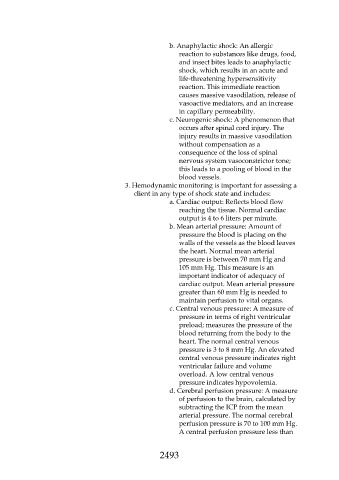Page 2493 - Saunders Comprehensive Review For NCLEX-RN
P. 2493
b. Anaphylactic shock: An allergic
reaction to substances like drugs, food,
and insect bites leads to anaphylactic
shock, which results in an acute and
life-threatening hypersensitivity
reaction. This immediate reaction
causes massive vasodilation, release of
vasoactive mediators, and an increase
in capillary permeability.
c. Neurogenic shock: A phenomenon that
occurs after spinal cord injury. The
injury results in massive vasodilation
without compensation as a
consequence of the loss of spinal
nervous system vasoconstrictor tone;
this leads to a pooling of blood in the
blood vessels.
3. Hemodynamic monitoring is important for assessing a
client in any type of shock state and includes:
a. Cardiac output: Reflects blood flow
reaching the tissue. Normal cardiac
output is 4 to 6 liters per minute.
b. Mean arterial pressure: Amount of
pressure the blood is placing on the
walls of the vessels as the blood leaves
the heart. Normal mean arterial
pressure is between 70 mm Hg and
105 mm Hg. This measure is an
important indicator of adequacy of
cardiac output. Mean arterial pressure
greater than 60 mm Hg is needed to
maintain perfusion to vital organs.
c. Central venous pressure: A measure of
pressure in terms of right ventricular
preload; measures the pressure of the
blood returning from the body to the
heart. The normal central venous
pressure is 3 to 8 mm Hg. An elevated
central venous pressure indicates right
ventricular failure and volume
overload. A low central venous
pressure indicates hypovolemia.
d. Cerebral perfusion pressure: A measure
of perfusion to the brain, calculated by
subtracting the ICP from the mean
arterial pressure. The normal cerebral
perfusion pressure is 70 to 100 mm Hg.
A central perfusion pressure less than
2493

